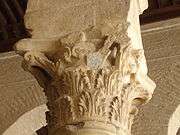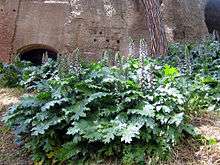Acanthus mollis
| Acanthus mollis | |
|---|---|
| | |
| Inflorescence of Acanthus mollis | |
| Scientific classification | |
| Kingdom: | Plantae |
| (unranked): | Angiosperms |
| (unranked): | Eudicots |
| (unranked): | Asterids |
| Order: | Lamiales |
| Family: | Acanthaceae |
| Genus: | Acanthus |
| Species: | A. mollis |
| Binomial name | |
| Acanthus mollis L. | |
| Synonyms[1] | |
| |
Acanthus mollis, commonly known as bear's breeches,[2] sea dock,[2] bearsfoot or oyster plant, is a herbaceous perennial plant with an underground rhizome in the genus Acanthus. It is regarded as an invasive species in some jurisdictions.[3]
Etymology
The name of the genus derives from the Greek term ἄκανθος, akanthos, the name of the plant in Greek; it was imitated in Corinthian capitals; the word is related to ἄκανθα, akantha meaning "thorn" referring to the thorn-bearing sepals, or any thorny or prickly plant in Greek, while the Latin name of the species, mollis meaning "soft", "smooth", refers to the texture of the leaves.[4]
Description

Acanthus mollis reaches on average 30–80 centimetres (12–31 in) of height, with a maximum of 180 centimetres (71 in), inflorescence included. It has basal clusters of deeply lobed and cut, shiny dark green leaves, soft to the touch, up to 40 centimetres (16 in) long and 25 centimetres (9.8 in) broad, with a long petiole. The inflorescence is a cylindrical spike 30–40 centimetres (12–16 in) long and can produce up to 120 flowers. The flowers are tubular, whitish, and lilac or rose in colour. Each flower is up to 5 centimetres (2.0 in) long and it is surrounded by three green or purplish bracts. The central bract is spiny and larger than the other two. The calyx has two lips: the upper is purple on top, rather long and forms a kind of "helmet" on top of the corolla. The corolla is reduced to a white lower lip, trilobed, with purple-pink venation. The four stamens are fused to the corolla and look like tiny brushes. This species flowers in late spring or early summer, from May through August.
Reproduction
Acanthus mollis is entomophilous and it is pollinated only by bees or bumble bees large enough to force their way between the upper sepal and the lower, so that they can reach the nectar at the bottom of the tube. The fruit is an ovoid capsule containing two to four large black seeds. The dispersal of seeds is by the wind (anemochory).
These plants are usually propagated from tubers and tend to form large, localized clumps which can survive for several decades and look statuesque when well-grown, but its suitability as a garden plant is lessened on account of its invasive nature (new plants are produced readily both from seed and portions of root) and its susceptibility to powdery mildew and attacks from snails.
Distribution
This plant is native to the Mediterranean region from Portugal and northwest Africa east to Croatia and it is one of the earliest cultivated species.
Habitat
This garden plant is also quite common in the wild. It grows in dry areas, roadsides and wastelands, especially in rocky and bushy places. It is tolerant of drought and shade and generally does not exceed an altitude of 300 metres (980 ft) above sea level.
Culture
The leaves of this plant are generally considered by historians to have been the design inspiration for the Corinthian order capitals of Greco-Roman architecture.[5] Virgil describes Helen of Troy as wearing a dress embroidered with acanthus leaves.[6]
Gallery
-

Plants of Acanthus mollis
-
Inflorescence of Acanthus mollis
-
Close-up on stamens of Acanthus mollis
-
Close-up on a flower of Acanthus mollis, lateral view
-

Fruits of Acanthus mollis
-

Flowering plant in the ruins of the Palatine Hill, Rome
-
Acanthus mollis inflorescence
-

Acanthus mollis - MHNT
References
Notes
- ↑ "The Plant List: A Working List of All Plant Species". Retrieved 18 December 2014.
- 1 2 "USDA GRIN Taxonomy". Retrieved 18 December 2014.
- ↑ Weeds of Australia, Biosecurity Queensland edition: Bear's breeches, Acanthus mollis Archived April 2, 2015, at the Wayback Machine.
- ↑ ἄκανθος, ἄκανθα. Liddell, Henry George; Scott, Robert; A Greek–English Lexicon at the Perseus Project. "άκανθος"., άκανθος (in Greek). Centre for the Greek Language. Harper, Douglas. "acanthus". Online Etymology Dictionary. mollis. Charlton T. Lewis and Charles Short. A Latin Dictionary on Perseus Project.
- ↑ Vitruvius. On Architecture. Book IV.
- ↑
Other sources
- "Factsheet - Acanthus mollis". keyserver.lucidcentral.org. The University of Queensland. 2011. Retrieved 8 January 2016.
- Pierre Delforge - Orchids of Europe, North Africa And the Middle East - 2006, Timber Press
- Pignatti S. - Flora d'Italia (3 voll.) - Edagricole – 1982, Vol. III
- Tutin, T.G. et al. - Flora Europaea, second edition - 1993
External links
- The Introduced Flora of Australia and its Weed Status, by R.P.Randall, Department of Agriculture and Food, Western Australia
- Biolib
- Acanthus mollis in the Canary Islands
- USDA
- Malta Wild Plants
| Wikimedia Commons has media related to Acanthus mollis. |
| Wikispecies has information related to: Acanthus mollis |